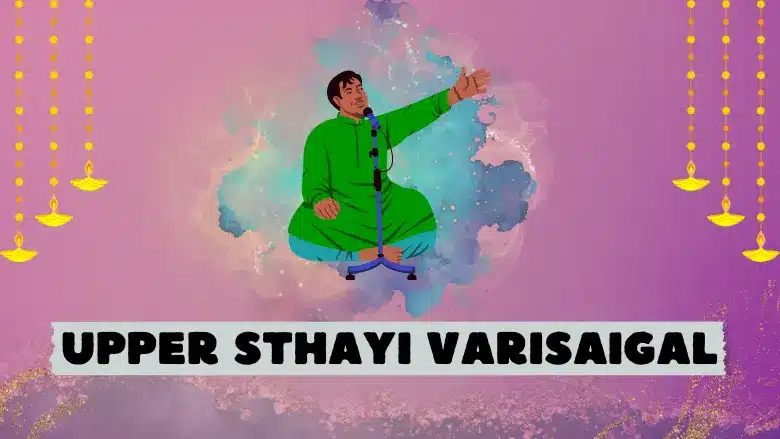Surprisingly, there are more than 100 taals and 1000s of ragas branching out of melakarta ragas in Carnatic Music. It happens to be one of the oldest music systems in India. Understanding these intricate yet beautiful melodic and rhythmic frameworks truly takes a lifetime and beyond. One of the essential lessons to increase one’s sthayi (vocal range) is upper sthayi varisaigal exercises
Hot Tip
There are three voice registers namely, Mandra, Madhya and Tara sthayi in Carnatic music.
upper sthayi varisaigal practice helps to improve and navigate through the swaras of a raga in Tara sthayi or higher voice register. In this text, we will explore the concept of upper sthayi varisaigal, importance of upper sthayi varisaigal, structure of swaras ,the role it plays in improving the skills and some tips to practice sthayi varisai.
Upper sthayi varisaigal exercises
Before we get into the upper sthayi varisai lyrics in English, let’s first understand what sthayi is. Sthayi refers to a specific range of swaras in a raga. Like i said earlier we have three main registers in Carnatic Music.
Mandra sthayi
It is the lower sthayi where the notes sound deep and resonant. This is the first sthayi and includes the lower ‘Sa,’ shadaja.
Madhya sthayi
It is the middle register of a vocalist. This is often referred to as the most comfortable range for carnatic musicians.
Tara sthayi
The upper or the highest sthayi where the swaras are bright and intense. One of the lessons to master notes in tara sthayi is upper sthayi varisaigal in Carnatic Music.
Now back to learning upper sthayi varisaigal.
How to sing upper sthayi varisaigal for beginners?
Basically, a series of swaras in ascending and descending order consisting of taar sthayi swaras. These patterns help learners get familiarized with the sound of raaga and the pitches of the swaras.
[TABS_R id=12240]
Structure of upper sthayi varisaigal
First exercise of upper shayi varisaigal in Carnatic music
This set begins with the ascending pattern of S R G M P D N S and the pattern deviates from there. The swaras up until the higher sthayi S’ (Shadjam) and R’ (Rishabam) is used in the first exercise. The descending order has a distinct pattern of swaras, d n S R, S n d P. Here one can learn the clarity in pitch until S’ and back to S.
Second exercise of melsthayi varisaigal
The Second exercise of Melsthayi varisaigal is designed to learn repetition of the same swaras. I always thought that the addition of the repetitive notes like S S, R S, S R S n d, p helps a learner to maintain evenness in their singing.
Third exercise of upper sthayi varisaigal
This set introduces the learners to larger interval jumps. Swar patterns like d n S R, G R, S R can help improve agility. The higher octave G requires a little more control and vocal precision. These exercises enhance the overall flexibility and range of the learner.
Fourth exercise of upper sthayi varisaigal in carnatic music
In the fourth set, a combination of complex swaras up until higher octave M ‘. As you can see, each exercise goes up one pitch and therefore is a great tool to increase your vocal range.
Upper sthayi varisaigal practice tips
Basically, upper sthayi varisaigal practice tips is an overview of how you can learn and practice these exercises. Let’s also look into some of its importance.
- Make sure you understand that the concept of pitch accuracy is essential for upper sthayi varisaigal practice. Listen to the sound of your shruthi even for many hours for familiarity.
- These lessons require a good amount of vocal strength and control for singing high notes. Consistent ypper sthayi varisaigal practice is an excellent solution for it.
- We all know that singing simple patterns to complex patterns improves vocal agility. Slowly and gradually increase the speed or the tempo of the lessons.
- Practising slowly helps in understanding the pitches of the swaras and the swarasthanas properly.
- Avoid tension in your throat while you sing in upper sthayi. Otherwise, it could make your throat hurt and hinder upper sthayi varisaigal practice.
- Focus on making smooth transitions between lower and higher pitches.
- Try adding little ornamentations like gamakas to make it sound rich.
FAQs
What is Upper Sthayi Varisaigal in Carnatic music?
It is a lesson in Carnatic music designed for the purpose of learning to sing high pitches.
How to practice Upper Sthayi Varisaigal exercises?
Make sure you understand that the concept of pitch accuracy is essential. Slowly and gradually increasing the speed or the tempo of the lessons is a great way to practice Upper Sthayi Varisaigal exercises.
How to sing upper sthayi varisai notes in Carnatic music?
Upper sthayi varisai notes must be sung with a relaxed throat, with proper tala and with accurate pitches.
What is the difference between lower and upper sthayi varisais?
Lower Sthayi Varisais focus on lower pitched swaras, while Upper Sthayi Varisais target higher pitched swaras, requiring greater vocal control and agility.
Importance of upper sthayi varisais in Carnatic music
The major Importance of upper sthayi varisais is the mastery of higher registers.
What is the purpose of Upper Sthayi Varisaigal practice ?
vocal strength especially while singing high pitches.
How to improve upper sthayi varisai singing?
Consistent practice is an excellent way to improve singing upper sthayi varisai lessons.
What is the upper sthayi varisai raga?
Upper sthayi varisai ragas is sung in Mayamalava gowla.
What is the Upper sthayi varisai meaning?
It means higher octave pitches.
Related Blogs: Kalyani Raagam































